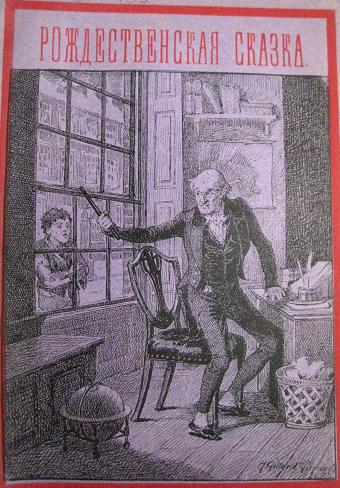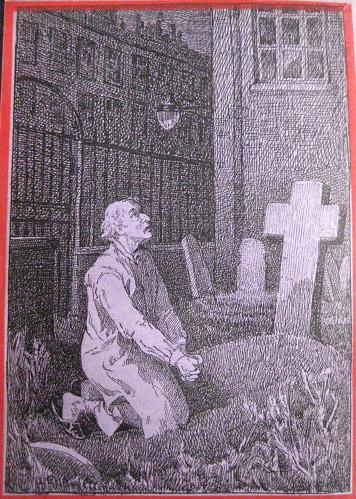A Christmas carol in Russian : translations of Dickens in the UL

Front cover illustration for Rozhdestvenskaia skazka, by H. Gillard Gordon.
2012 has marked 200 years since the birth of Charles Dickens, and the year has seen many celebrations and achievements far and wide. A local example is the UL Music Deparment's current exhibition, 'Inspired by Dickens : celebrating Charles Dickens' bicentenary'. To find out more about that exhibition, which can be seen by readers until the 23rd of January, click here.
Dickens has always enjoyed popularity in Russia, and this is to some extent reflected in the UL's holdings. While the Library does not usually purchase works in translation (this is a very broad statement but certainly quite true in terms of English-language books translated into foreign languages), translations of some major writers are occasionally bought. The earliest and probably the most delightful Russian translation of Dickens in the UL is the Rozhdestvenskaia skazka (A Christmas carol) shown in the illustrations. Published in Moscow in 1887, it is in fact an abridged translation and is a mere 36 pages long. Readers keen to remind themselves quickly of the tale of Skrudzh and Timosha can order this wonderful item up to consult in the West Room.
A Christmas carol is also part of the next oldest Dickens translation, printed in 1898. This is volume 16 of a multi-volume Dickens set published in St Petersburg in the late 1890s (the UL sadly lacks the rest of the set). It contains all the Christmas stories, with no apparent abbreviation of any. A Christmas carol is called Rozhdestvenskaia pesn' v prozie - the 1887 title detailed in the previous paragraph is technically 'A Christmas fairytale' while this is 'A Christmas song in prose'). The names of the characters are also slightly different in the two editions. Scrooge becomes Skrodzh rather than Skrudzh, and Tiny Tim becomes simply Tini Tim, a name which would have meant little to readers without English knowledge, whereas the 1887 diminutive reflected the original more effectively. The 1898 volume can be consulted in the Rare Books Reading Room.

Back cover illustration for Rozhdestvenskaia skazka, by H. Gillard Gordon.
Of the remaining Russian translations of Dickens in the UL, the most significant by far is the 30-volume set produced in Moscow between 1957 and 1963. Its volumes can be ordered to the Reading Room and are therefore borrowable. The remainder of the Russian translations are also borrowable:
- Kroshka Dorrit (Little Dorrit) from 1937;
- two translations of David Copperfield (David Kopperfild (or Kopperfil'd with a soft sign)): an incomplete copy from 1939, with volume 1 lacking, and a single-volume copy from 1953; and
- the 2-volume Torgovyi dom Dombi i syn (Dombey and Son) from 1935-6.
The translation and reception of Dickens in Russia is the subject of some envy-inspiring research currently being undertaken by Dr Emily Finer of the University of St Andrews for her projected book, The best of times, the worst of times: reading Dickens in Soviet Russia. As part of her work, Dr Finer has produced a 3-question online survey to find out about Russian-speakers' experiences of reading Dickens in translation and their thoughts about his popularity in the Soviet Union. To take part in the survey and contribute to this fascinating area of research, click here. Readers will get a chance to learn more about Dr Finer's work in 2013, when The reception of Charles Dickens in Europe, to which she has contributed a chapter about Soviet Russia, is due to be published.
If you are interested in the UL's holdings of translations of Dickens into other languages, an advanced search in Newton specifying Dickens as author and selecting the language you're interested in from the drop-down list at the bottom would work.
Happy Christmas and Happy New Year from the UL!
